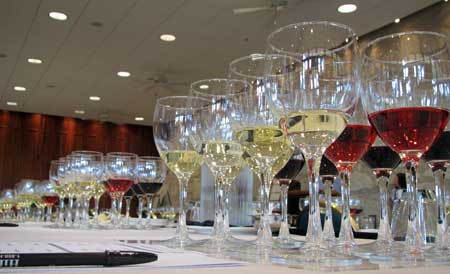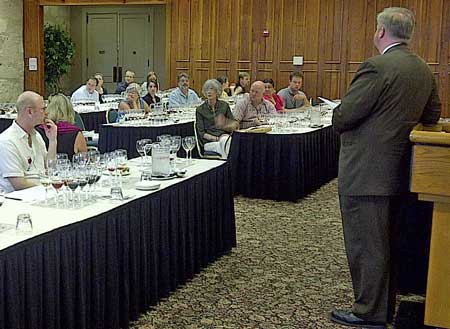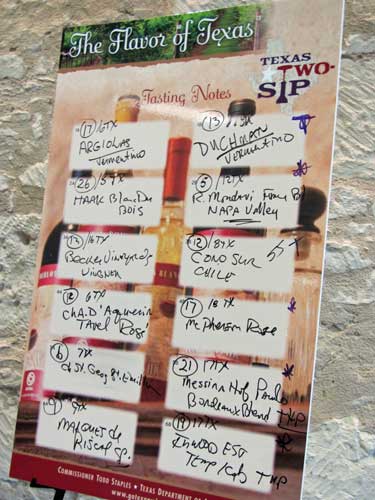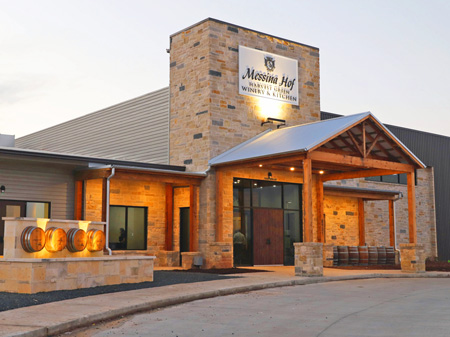Culinaria Texas Two-Sip: Be There…Be Surprised
On tables with white linens at San Antonio’s Hilton Palacios Del Rio, twelve wines were poured and presented before each audience participant and panelist. By eye, it was obvious that six were white wines, two were rosés, and four were red wines. There were no bottles presented or winery names visible on the tables or, in fact, anywhere in the room. The only thing discernible was that the wines were arranged in six flights of two wines each (1A-B, 2A-B…6A-B). That’s all.
This is how things started out Saturday evening when I joined Steve Krueger, Sommelier at the Westin La Cantera, as a panelist with three distinguished winery representatives in San Antonio Texas for the Culinaria Texas Two-Sip wine tasting that included Dr. Richard Becker, Becker Vineyards; Bill Esley, Duchman Family Winery; Robin Allen, Messina Hof Winery. Our purpose was to lead the tasting, a blind tasting, with an audience of about thirty ready-and-waiting tasters.
Our job as panelist was to solicit comments from the audience as we tasted each flight and to encourage them to think, grape varieties, wine styles, geographic locations and if the wine was from Texas or not. I had an additional job requirement: record keeper. At the completion of tasting of each flight I asked the crowd (panelist not included) two questions: (1) Which wine was their favorite, and (2) which one did they think was the Texas wine. Sometimes, I asked them what grape varieties from which they thought the wines were made. Then, I did the reveal: telling the audience the names of both the Texas and non-Texas wines in each flight.
IMPORTANT: One additional point worth noting particularly if you are one of the people that think that the deck may have been stacked in favor of the Texas wines. The prices for the Texas and non-Texas wines averaged very close. Sometimes the Texas wine was more expensive and in other cases the non-Texas wine was more expensive, but the average price for the six Texas wines was $21.82. By comparison, the average price for the non-Texas wines was $20.49. Not bad to say that, on the world stage, Texas and its premium wineries are still considered a small wine producers.
Flight 1 – Two white wines were presented, 6A was noticeably more yellow-green in color and aromatic than its partner, but 6B carried more flavor on the palate. Both were made from a grape called Vermentino. When I asked the crowd if they could tell what varietal it was, answers came back Chardonnay and Sauvignon Blanc. 6A was from wine producer Argiolas from the island of Sardinia (off the Italian Coast) and 6B was from Duchman Family Winery in the Texas hill country. The results were: 17 people preferred the Argiolas while 13 preferred the Duchman wine (nearly a tie);however, the tasters picked Duchman Vermentino the Texas wine 18 to 6. While nearly a tie for preference, Duchman Vermentino held a distinct price advantage: $9.99 to $16.99 for the Argiolas Vermentino.
Flight 2 – The wines were white and presented a yellow straw color with just a slightly deeper hue in wine 2A. The tasters in the audience verbalized essence of citrus, apple, pear in wine 2A and lemon/citrus and cut grass for wine 2B. When asked about the grape variety, the vast majority responded that it was Sauvignon Blanc or Viognier and that they preferred wine 2A over wine 2B by a score of 26 to 5. They indicated that they thought that 2B was the Texas wine. At this point, I had to admit that 2A and 2B were not made from the same grape. Wine 2A was made from Blanc Du Bois (a French-American hybrid, grown on the Texas Gulf Coast) while wine 2B was Robert Mondavi Fume Blanc made from Napa Valley-grown Sauvignon Blanc. What came next was perhaps the biggest surprise of the event. In a head-head-to-head blind tasting, the overwhelming majority of the tasters chose Haak Blanc Du Bois (2A) as their favorite of the flight AND didn’t pick it as a Texas wine!
Flight 3 – Again, two white wines were presented offering yellow straw (3A) and pale straw (3B). The tasters described Wine 3A as soft with “multilayered” characteristics or floral, peach and vanilla while wine 3B was more “monochromatic” offering a singular lemon-lime note with mouthwatering crispness. It was obvious that the crowd was having a tough time evaluating the wines in this flight. The vote indicated that about half of the tasters preferred 3A and half 3B. They picked 3A as the Texas wine and after some discussion, they named South America as the likely source of 3B. However, when asked what grape was involved, nobody immediately said Viognier. I think that they were still reeling from our grape variety “trick” from Flight 2. In this flight, while the wines were both made from Viognier, the wine styles were immensely different. Wine 3A was Becker Vineyards Viognier and made in a classic French style with oak aging and malolactic (ML) fermentation, whereas 3B was Cono Sur Viognier from Chile made without oak aging or ML in a simple, but pleasing style.
Flight 4 – Two rosé wines were poured. The first (4A) was slightly salmon-pink whereas the second (4B) was more red-pink. To me this was a major hint, but I did not let on to this fact with the audience. Descriptors from the tasters presented were watermelon, raspberry and minerally for wine 4A and cherry for 4B with its hint of sweetness (also a hint in my palate’s eye). After the tasting and commenting was completed, I called for the vote which came back with wine 4B the winner 17- 12 and the crowd picked it as a Texas wine 18-6. I revealed that wine 4A was a French rosé from Chateau D’Aqueria located in the southern region of Tavel. Wine 4B was Texas’s own McPherson Cellars Rose of Syrah.
Flight 5 – Two red wines were paired for this flight and both were deep red-purple in color with the crowd noting that wine 5B was nearly opaque. To me, this suggested that 5B could be from a warmer growing region and possibly a new world region where the ripeness and extraction are the norm. Wine 5A, by comparison, was more minerally and offered more “vanilla extract” versus 5A’s fruit-forward character and what I noticed as the punch of American oak. The audience overwhelmingly preferred wine 5B by a score of 21-6 and deemed it the Texas wine 17-7. The reveal showed that Wine 5A was Chateau St. Georges St. Emilion from the Bordeaux region of France and 5B was Messina Hof Winery Paulo Bordeaux Blend. From the responses of the audience, I think that this was the most surprising flight from the stand point that they picked a Texas wine and found it their favorite next to a comparably priced red wine from Bordeaux, France.
Flight 6 – To me, this was perhaps the most “interesting” flight of the evening which included two red wines of red garnet color that suggested significant oak and/or bottle aging to them. Both were dark with a somewhat greater extraction observed in wine 6B than that in 6A, but 6A was more aromatic. When asked about their description of wine 6A (Herederos del Marques de Riscal Reserva Rioja), the audience first went with dark fruit and then after some hesitation, one gentleman said that it smelled “like a farm”. This is the often cited “barnyard” or “wet earth” in old world-styled European red wines. By comparison, wine 6B offered black cherry and vanilla characteristics. The audience clearly preferred wine 6B (Inwood Estates Tempranillo-Cabernet Blend) by a score of 19-9 and picked it as a Texas wine (17-9). After first guessing the grape variety as Merlot, a pick that was off the mark, the crowd agreed that it must be Tempranillo. To this, the panel added that both wines also contain a good helping of Cabernet Sauvignon.
As usual, blind tastings provide suspense and surprises, and this Texas Two-Sip was spot on the mark for both.
The clear preference of Haak Dry Blanc Du Bois versus the wildly popular Robert Mondavi Fume Blanc was a surprise for me (and also for the other panelists and to the audience, too). Bill Esley from Duchman Family Winery who was sitting next to me on the panel said that it was his first opportunity to taste Blanc Du Bois. He indicated and it really opened his eyes to the high quality point that this hybrid grape has achieved in Texas. The fact that Raymond Haak’s Blanc Du Bois could be poured in the same flight as a widely popular vinifera wine like Mondavi Fume Blanc and come out the clear winner is an acknowledgement of both the character of this wine. The Culinaria Texas Two-Sip also showed the benefit of blind tastings. They unleash our minds and our palates to discover the truth.
Overall, the audience scored a 4-2 preference for Texas wines (with the two non-preferred flights nearly a tie).





Dr. Kane, you did an OUTSTANDING job at the Texas Two Sip Tasting! If was great fun! I had every confidence in the Texas wines going into it and I will admit a bit of nervousness. I did not expect them to be FAR superior to their other region counterparts. Blind tasting is such a great exercise, wine drinkers need to do it more often. Thank you for coming, helping and writing this great blog.
Russ: What a fantastic job! Thank you and your panelist for helping educate the wine consuming world about great Texas wines. I had a conversation a few years ago with the President and Winemaker for a promionent winery in Florida, where Blanc du Bois was developed. We were discussing how biased many wine competitions were to awarding medals to little known varietals like Blanc du Bois. I, jokingly suggested that one of us producing Blanc du Bois should submit Blanc du Bois in the varietal category of Sauvignon Blanc just to see how it would be judged. After a pause, she said, “I did”. I inquired, “How did it perform?” She said the judges awarded it a Gold medal!